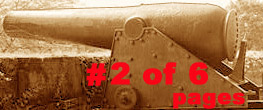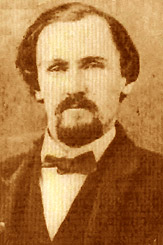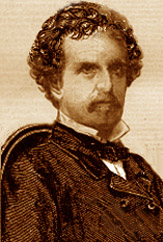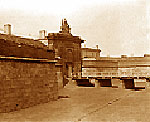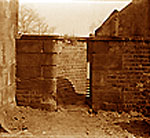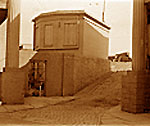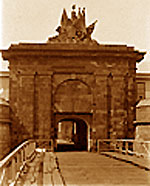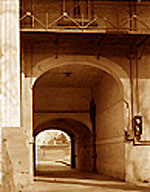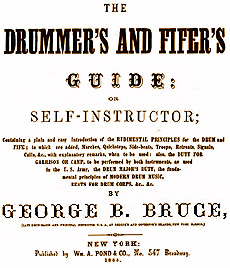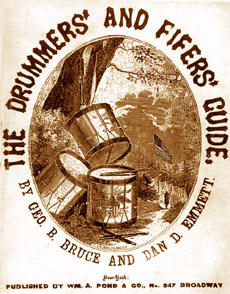Beall and fellow Confederate saboteurs had made two unsuccessful attempts to free Confederate prisoners of war from Johnson's Island on Lake Erie in Ohio. He was captured December 14th, 1864, in connection with a third failed attempt near Buffalo, transported to New York City, confined in Police Headquarters there, and then lodged in Fort Lafayette in the lower bay. That fort was razed in the 1960s. The reef where it had stood became the foundation for a Verrazano Narrows Bridge tower.
In 1860, Brady -- a former Tammany Hall leader -- had been the unsuccessful candidate for NYS governor on the States Rights (called pro-slavery by opponents) ticket of that wing of the Democratic Party aligned with Presidential candidate John Breckinridge, the former Vice President from Kentucky. In 1867, Brady would serve as the lead lawyer in the legal defense team for the federally indicted Jefferson Davis.
On January 17, 1865, John Y. Beall was tried by a military commission for "violation of the laws of war." The opinion by the reviewing authority reveals that Beall, holding a commission in the Confederate Navy, came on board a merchant vessel at a Canadian port in civilian dress and, with associates, took possession of the vessel in Lake Erie; that, also in disguise, he unsuccessfully attempted to derail a train in New York State, and to obtain military information. His conviction by the Commission was affirmed on the ground that he was both a spy and a "guerrilla," and he was sentenced to be hanged. The Beall conviction and death sentence hardly surprised anyone then or now, given the circumstances. Questioned at the time and subsequently was Lincoln's refusal to reduced the penalty to imprisonment. The clemency pleas of 85 Congressmen, 6 Senators, and numerous editors, clergy, business leaders, and other public figures failed to move the President beyond granting a brief delay to allow Beall's mother to visit her son prior to execution. Though the property damage was major in the Lake Erie escapade, no serious physical injury had been inflicted on anyone. The solicitude that had been shown the Erie Lake steamer crew and passengers contrasted markedly with the reckless disregard later shown by Beall for the safety of the passengers and crew of the train he had tried to derail. Judge Advocate General Joseph Holt underscored this point when he declared "Beall's last enterprise was a crime of fiendish enormity which cries loudly for the vengeance of the outraged law." Despite a virulent anti-Yankee preamble, the Richmond Examiner Wednesday, March 1, 1865, account of the execution on Governors Island, based on extracts from Northern newspapers, is remarkably detailed, matter-of-fact and straight forward: Beall was of medium size; had light colored hair and moustache, blue eyes, and his countenance wore a pleasant expression. . . . After his conviction he was taken from Fort Lafayette, where he had previously been confined, and placed in the "garrison," a prison in Fort Columbus, on Governor's Island. On Wednesday, before the time first appointed for his execution he was put into a cell and closely guarded. During his imprisonment he has at no time been disorderly, but has treated the officers in charge of him with uniform courtesy, and sometimes conversed freely. . . On Saturday last Beall's mother arrived here from Harper's Ferry, near where the family resided, and obtaining a pass from General Dix, saw the prisoner. She remained with him for a considerable time; but it is understood returned southward immediately, and did not see him afterwards. Three clergymen - two of the Roman Catholic church, and one of the Episcopal (Rev. D. Weston) - have visited Beall, by his request; and a few other acquaintances or friends have seen him. It appears that Beall was a religious man; he belonged to the Episcopal church, and was once a lay member of the Diocesan convention of his state. Twice on Friday he took the sacrament, administered by Dr. Weston.
Shortly before one o'clock Friday afternoon Captain Talman, who had charge of the arrangements for the execution, United States Marshal Murray, who was present by request, and the executioner, entered the cell of the condemned man. He promptly rose and said he was at their service. He added that he knew their errand, and said he wished the work to be done quickly. A moment afterwards he remarked: "It is only a question of muscular power - I think I can bear it." His arms were then pinioned, a military cape was thrown over his shoulders, a black cap was put on his head, and the officers and the prisoner emerged from the cell and took their place between two lines of soldiers, who formed the guard to the place of execution. Beall marched out of the garrison by the side of Dr. Weston, who read the commendatory prayer from the Episcopal liturgy. The Marshal and executioner and two friends of the prisoner followed. Beall marched with a firm step in the direction of the gallows, which had been erected on the south side of Fort Columbus. As he ascended the brow of a hill, from which the gallows frame was visible he looked hurriedly at the instrument and seemed to smile. The preparations had not been completed, and a halt on the hill was ordered. At this point he talked with his spiritual adviser. Looking upward, he remarked that the day was a pleasant one. Immediately he added: "The sun shines brightly; I now see it for the last time." He was, however, perfectly calm and composed. The order was then read by the Post Adjutant, Lieutenant Keiser, Second United States infantry. When the Adjutant had finished, Rev. Dr. Weston intoned aloud the prayer for the dead, the soldiers listening with breathless anxiety, and many tears running down their cheeks. Marshal Murray and the Provost Marshal of the fort stepping up, asked the prisoner if he had anything to say, to which he replied: "I protest against the execution of the sentence. It is absolute murder - brutal murder. I die in the defense and service of my country." Before the cap was drawn over his eyes, on being asked if he wished to say anything further, he said: "No, I beg you to make haste." At 13 minutes past one o'clock the black cap was drawn over the culprit's face, the Provost Marshal drew his sword, a noise was heard from inside the box, and the form of John Y. Beall was dangling in the air. The only movement noticeable in the body was a convulsive movement of the right leg, a shrugging in the shoulders and a few twitches of the hand. After hanging just twenty minutes the body was lowered down, when a medical examination by Dr. Connor, United States Army, proved that the neck was broken instantly, thus ending the earthly career of Beall without any agony. It was then taken to the hospital, whence it will be given to the friends of the deceased for interment. The Beall execution in 1865 was not the first but may have been the last on Governors Island. Only three weeks earlier, a James Devlin had been executed by firing squad after having been convicted of desertion and bounty jumping -- that is, deserting after collecting enlistment bounty money, re-enlisting elsewhere, deserting again after collecting enlistment bounty money, etc. Other Governors Island executions:
A month after the Governors Island execution of would-be train derailer Beall, the Fort Lafayette execution of Confederate Captain Robert Cobb Kennedy took place. Former West Pointer Kennedy was the only one eventually caught, charged, and convicted among the Southern terrorists who threw firebombs into hotels, theaters, museums and docked ships in a plot to burn down New York City Nov. 25, 1864. Kennedy and Beall would have known each other from their work as saboteurs operating out of Canada under Jacob Thompson, Confederate spy mastermind who resigned as President James Buchanan's Secretary of the Interior day before Mississippi seceded from the Union. Thompson had been a six-term Congressman from Mississippi. There is some indication of Kennedy involvement in the Beall plan to derail a train to free Confederate POWs. Beall and Kennedy may also have known each from their being POWs at Fort Lafayette. Why one was transported to Governor's Island to be hanged while the other remained at Fort Lafayette to be hanged there -- becoming the last Confederate soldier executed by Union military during the Civil War -- is unclear. On the appointed day, March 25, 1865, as Kennedy stood upon the Fort Lafayette gallows and the hood was about to be placed over his head, the Confederate captain burst into song before the trap opened beneath him:
Trust to luck, trust to luck, Though Kennedy's spur-of-the-moment singing was done a cappella, the musical score for the popular troop song would have been readily available to Fort Lafayette musicians had they wanted and been permitted to provide instrumental accompaniment. Trust to Luck began at the bottom of Page 45 and continued on Page 46 in The Drummer's and Fifer's Guide, widely regarded as the standard drum and fife instruction and song book of the era. The book had been chiefly written by Drum Major George B. Bruce who, until shortly before its publication in 1862, was Principal Instructor of the School of Practice for U.S.A. Field Musicians on Governor's Island. Drum Major Bruce's name appeared as author on the title page. Drum Major Bruce's name appeared as the author of the Preface. In it he writes of himself in the third person: The Author . . . is specially fortunate in securing the aid of Daniel D. Emmett, late principal fifer in the 6th U.S. Infantry, whose name is a sufficient guarantee for the correctness of the Fife department of this work. While Emmett had indeed been a 6th U.S. Infantry fifer, Bruce or his publisher or both were stretching the point by using the phrase, "late principal fifer." Actually 27 years prior to publication of the book, Emmett had joined the 6th as a boy on March 3, 1835, but he was discharged five months later -- July 8, 1835 -- after he was discovered to be underage. His assigned role during his brief boyish stint as a military field musician was "lead fifer." Young Emmett had joined the Army to learn music. Though the Army dropped him, he didn't drop his passion for music. He eventually became a leading minstrel show performer and song writer. While a member of Bryant's Minstrels in New York City, he composed "Dixie Land" in the late 1850s, well before Lincoln's election or the South's succession. A native of Ohio, Emmett was a staunch Northerner whose father at that time was helping Southern slaves escape bondage. The Northerner's song about the South enjoyed huge popularity on both sides of the Mason-Dixon line, even after some states seceded. But its favor in the North declined quickly after its performance at the inauguration of Jefferson Davis as President of Confederacy. That had seemed to confer on Emmett's song unofficial status as the South's "national anthem." Nevertheless, Emmett had "name recognition" both North and South. Thus, in 1862, when the Governors Island Drum Major's book appeared in print, Emmet's name (that had not appeared on the title page and had only brief mention in Bruce's Preface) shared prominent and equal billing with Bruce on the cover. From the publisher's commercial marketing perspective, the value of the Emmett name went well beyond being sufficient guarantee of the work's fife correctness.
Emmett does get a kind of sub-title page of his own, Page 15, to introduce the fife section. With all the humility one may expect under the exigencies of book promotion, Fife Instructor Daniel D. Emmett's title page announces "the best selection of fife music ever offered to the public." On the next page, headlined "Remarks," two paragraphs appear above the flush right name "Daniel D. Emmett." The first paragraph is a collection of sentences giving various technical tips on learning, practicing and playing fife drills and music as well as selecting and maintaining a fife. The second paragraph is an endorsement of "the beautiful German Silver Fifes manufactured by Firth, Pond & Co. of New York, the publishers of this book." |
Click red-letter page number in top frame above or here below to access that page:
|
|
| |||||
|
|
|
|
|
|
|
| To Civil War & Correction menu. | ||
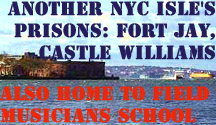 © NYCHS reserves and retains all rights to the text other than quoted excerpts. Non-commercial educational use permitted provided NYCHS and/or its web site -- www.correctionhistory.org -- credited as the source.
© NYCHS reserves and retains all rights to the text other than quoted excerpts. Non-commercial educational use permitted provided NYCHS and/or its web site -- www.correctionhistory.org -- credited as the source.
Associate Professor Jannelle Warren-Findley of the Department of History of Arizona State University is researching Governors Island's history for a National Park Service project. Information sent to webmaster@correctionhistory.org that might be helpful to her research will be forwarded to her. Or send the information directly to the e-mail address listed on her Arizona State University Dept. of History faculty page. See Page 6 for listing and links of the scores of on-line sources of Governors Island information and images used in this presentation. --- Tom McCarthy |
